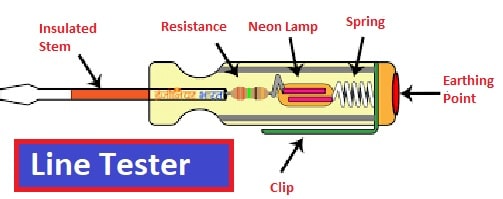A phase or line tester is an electrical testing device used to detect the presence of voltage in the electrical circuit.
For maintenance, troubleshooting, and checking of electrical equipment the phase tester is a very useful tool. We use it to detect the live potential in the electric circuit. Thus the line tester is used to detect the voltage. The line tester does not measure the voltage, it only shows whether the voltage exists at a particular point or not. The line tester never detects the current in the circuit.
What is Phase or Mains Tester?
The line tester is the most useful tool for testing and identification of phase conductors in electrical installation.

Parts of Line Tester

Metallic Rod and Mouth
The insulation covers the metallic rod is of cylindrical type and its flat part of the insulation tester. The farthest part of the rod is conductive and it makes the connection with the live part. The other end of the metallic rod has its connection with the current limiting resistor, neon bulb, element, and metallic cap screw respectively. It is a cylindrical metal rod.
Body and Insulation
All the parts of line tester like Resistance, Neon bulb, Element or metallic spring, and Metallic Cap screw have its mounting inside the enclosure.
Resistor
The resistor limits the current flowing through the neon lamp. The resistance has its connection between the cylindrical rod and the neon element. The current flows through the live conductor to the earth when we touch the end cap of the tester. The resistance value selection is very important. The current flowing in the circuit depends on the value of the resistance and the human body resistance.
Neon Bulb
The neon bulb has a connection between resistance and metallic spring. When a small current flows through the resistor it starts glowing which indicates that the measuring point has live potential. The neon lamp glows when the circuit is live.
Element (Metallic Spring)
The metallic spring connects the Neon bulb and metallic cap screw.
Metallic Cap Screw and Clip
The metallic cap screw has its connection to the spring. The spring element has a connection with a neon bulb. With a metallic cap screw, we can tighten all the components inside the tester. The clip attached to it is useful for clipping the tester inside the pocket.
Working of Phase or Line Tester
When we touch the flat end of the metallic rod of phase or line tester with naked Live/hot wire then the circuit completes and current starts flowing in metallic rod, and the neon bulb inside mains tester glows. The glowing of the neon bulb shows that there is a supply in the wire. If the neon bulb does not flow indicates that there is no supply in the phase wire.
To limit the current flowing through the neon bulb current limiting resistor is connected in the series of the neon bulb. The metallic spring is connected with a metallic cap screw which is in contact with our fingers. Thus, a very small current flows through our body to the earth and completes the circuit.
Safety Precaution while working
- Follow the proper electrical guide lines and take care
- Carry out electrical jobs under electrical supervisor.
- Never touch the open wire/Conductor even if the tester shows absence of phase or hot supply.
- Use Line Tester only for the supply voltage ranging from 100V-500V.
- Don’t use Phase or Line Tester with High voltages because it may cause electrocution.
- Handle the Line tester with care. Neon bulb or element may damage.
- The licensed electricians must work on electricity. It may be dangerous if the person does not have competency on working on electrical supply system.
- Electricity is very dangerous. Therefore, read all caution and instruction while doing electrical work.
- Keep concentration while working on electrical equipment & electrical system.
Read Next: